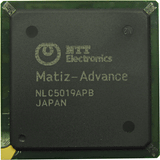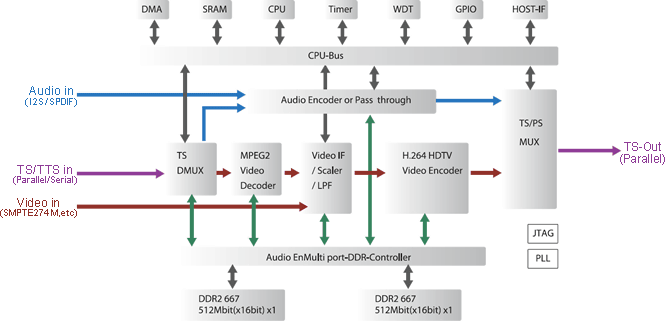NTT Electronics Releases High-Quality Full HD H.264 Encoder/Transcoder LSI
April 20, 2009
Tokyo, Japan - NTT Electronics Corporation, headquartered in Tokyo's Shibuya Ward (hereafter, NTT Electronics), today announced the release of the Matiz-Advance H.264/AVC encoder/ transcoder LSI.
Matiz-Advance is a single-chip encoder/transcoder LSI for professional use that performs real-time transcoding of high-quality video. Since Matiz-Advance's encoding control is compatible with CBR (*1) and VBR (*2), as well as with the optional Capped VBR (*3), it can be applied to a wide variety of video and audio equipment for professional use. Matiz-Advance also has an HDTV-SDTV downscaler and optionally supports flexible encoding control with its seamless bit rate change capability.
An increasing number of digital broadcasting systems are employing H.264/AVC as a video compression format these days because it provides both high compression and high quality video simultaneously. Most professional video equipment has traditionally used MPEG-2, but today's equipment is increasingly using H.264/AVC for applications such as image editing and archiving, which involves recording images, and for bandwidth-constrained services such as satellite broadcasting and IPTV. Matiz-Advance provides the best solution for these applications.
Matiz-Advance transcodes MPEG-2 images into the more compression-efficient H.264/AVC format, effectively reducing video data sizes by 50 percent or less while retaining high video quality. Matiz-Advance is especially useful in applications such as IPTV headends, video servers, and video editors. These applications require high-end encoders that can transcode content distributed and stored in MPEG-2 format into H.264/AVC format. The single-chip design of Matiz-Advance enables a more compact yet high-performance design of equipment.
NTT Electronics plans to add other functions to this LSI, such as closed captioning (*4), which is required for digital terrestrial broadcasting, CATV, and IPTV. This upgrade will be available to customers via a future firmware update.

Matiz-Advance H.264/AVC Encoder/Transcoder LSI
Matiz-Advance Block Diagram:

Key Product Features:
- Support for encoding Full HD H.264/AVC
- Support for transcoding from MPEG-2 to H.264/AVC.
- MPEG-2 HDTV to H.264/AVC HDTV/SDTV
- MPEG-2 SDTV to H.264/AVC SDTV
- Supports converting video formats while retaining excellent video quality
- HDTV to SDTV down-conversion
- Supports multiple video formats, including 1080i, 720p, 576i, and 480i
- Supports multiple audio formats, including MPEG-1 Layer 2 and MPEG-2 AAC
- Low power consumption
Main Specifications
| Compression Technology | H.264 | Encoder: | ISO/IEC 14496-10(H.264/AVC) |
|---|---|---|---|
| HDTV : High Profile Level 4.0 | |||
| SDTV : Main Profile Level 3.0 | |||
| MPEG-2 | Decoder: | ISO/IEC13818-2(MPEG-2 Video) MP@HL | |
| Video Input | SMPTE274M / SMPTE296M-2001 / ITU-R BT.656-4 | ||
| Stream Input | ISO/IEC 13818-2(MPEG-2 Video) | ||
| Stream Output | ISO/IEC 13818-1+Amd3 | ||
| Audio | Audio PES through(Transcode), various other formats(Encode) | ||
| Down Scaling | HDTV SDTV or through | ||
| Host Interface | 16bit data bus | ||
| Power Supply | Core: 1.2±0.1v, I/O: 1.8±0.1v / 3.3±0.3v | ||
| Power Consumption | 1.4W (Encode mode) | ||
| Package | 27mm x 27mm, BGA | ||
| External Memories | 512Mbit DDR2-667 x 2 | ||
Sales Price:
Open price
Product Release Date:
June 1, 2009
Supplementary information
Terminology
- *1
- CBR
- Abbreviation for Constant Bit Rate
- Since it provides stable image transmission, it is mainly employed in communication lines. - *2
- VBR
- Abbreviation for Variable Bit Rate
- Storage media, such as DVD and Blu-ray Disc, use this method. - *3
- Capped VBR
- VBR with a threshold value for the maximum bit rate. This method controls the generation of bitrates smaller than the threshold level.
- This method is used for applications where data streams share the bit rates within a limited bandwidth, such as multichannel broadcasting. - *4
- Closed Caption
- A textual video overlay representing the audio within an image stream for the hearing impaired.
NTT Electronics Contacts
Digital Video Sales Division